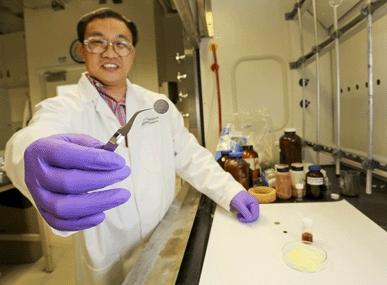Solid electrodes could unlock lithium-sulphur cell potential

The ORNL battery design, which uses sulphur, is also said to address flammability concerns experienced by other chemistries.
‘Our approach is a complete change from the current battery concept of two electrodes joined by a liquid electrolyte, which has been used over the last 150 to 200 years,’ said Chengdu Liang, lead author on the ORNL study published in Angewandte Chemie International Edition.
Scientists have been excited about the potential of lithium-sulphur batteries for decades, but long-lasting, large-scale versions for commercial applications have proven elusive.
Researchers were stuck with a catch-22 created by the battery’s use of liquid electrolytes: on one hand, the liquid helped conduct ions through the battery by allowing lithium polysulfide compounds to dissolve. The downside, however, was that the same dissolution process caused the battery to prematurely break down.
The ORNL team overcame these barriers by first synthesising a class of sulphur-rich materials that conduct ions as well as the lithium metal oxides conventionally used in the battery’s cathode. Liang’s team then combined the new sulphur-rich cathode and a lithium anode with a solid electrolyte material, also developed at ORNL, to create an energy-dense, all-solid battery.
‘This game-changing shift from liquid to solid electrolytes eliminates the problem of sulphur dissolution and enables us to deliver on the promise of lithium-sulphur batteries,’ Liang said in a statement. ‘Our battery design has real potential to reduce cost, increase energy density and improve safety compared with existing lithium-ion technologies.’
The new ionically-conductive cathode enabled the ORNL battery to maintain a capacity of 1200mAh per gram after 300 charge-discharge cycles at 60 degrees Celsius. For comparison, a traditional lithium-ion battery cathode has an average capacity between 140-170 mAh/g. Because lithium-sulphur batteries deliver about half the voltage of lithium-ion versions, this eight-fold increase in capacity demonstrated in the ORNL battery cathode translates into four times the gravimetric energy density of lithium-ion technologies, explained Liang.
The team’s all-solid design also increases battery safety by eliminating flammable liquid electrolytes that can react with lithium metal. Chief among the ORNL battery’s other advantages is its use of elemental sulphur, a plentiful industrial by-product of petroleum processing.
‘Sulphur is practically free,’ Liang said. ‘Not only does sulphur store much more energy than the transition metal compounds used in lithium-ion battery cathodes, but a lithium-sulphur device could help recycle a waste product into a useful technology.’
Although the team’s new battery is still in the demonstration stage, Liang and his colleagues hope to see their research move quickly from the laboratory into commercial applications. A patent on the team’s design is pending.
The study is published as ‘Lithium Polysulfidophosphates: A Family of Lithium-Conducting Sulphur-Rich Compounds for Lithium-Sulphur Batteries,’ and is available online here.
Source TheEngineer
